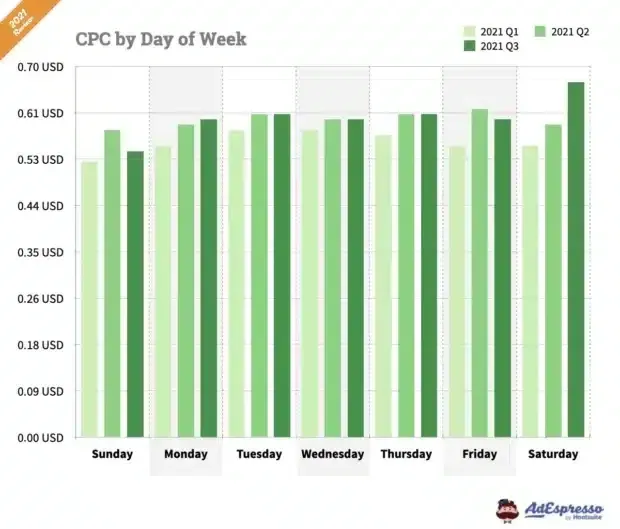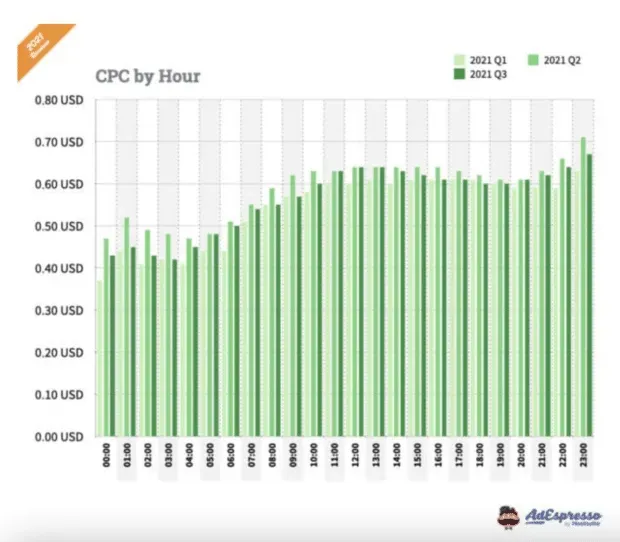Did you know that Facebook’s pay-per-click advertising campaigns allow your business to reach a potential audience of 2.11 billion people?
It’s right; Facebook is alive and well! Now under the Meta umbrella, Facebook PPC ads have long been a solid growth strategy when paired with organic content.
Experienced marketers know to keep an eye on profits and look for ways to save business money. Lowering your cost per click (CPC) on Facebook is one way to do this, so read on for tips on lowering your CPC and understanding how to get the most out of your Facebook ad campaigns.
What is pay-per-click advertising on Facebook?
Facebook pay-per-click advertising is an auction-based marketing strategy in which companies bid to show their ads to a predetermined audience. However, with CPC, you will only pay when a Facebook user clicks on your ad.
For example, if you’re a fashion brand, you could run a Facebook pay-per-click campaign to promote your latest product and include a call to action (CTA) that encourages users to click through and buy your latest collection.
Thousands of businesses use Facebook ads to grow, which is one of the reasons Facebook ads use an auction and bid-based strategy.
Given the limited number of ad spaces on the platform, Facebook considers many factors, including the total cost of an ad, its quality, and the expected frequency of actions (such as whether users will interact with an ad) to determine which ads will be shown to a particular target audience.
Facebook CPC is calculated as the total amount spent divided by the number of link clicks, and there are several different PPC campaigns you can run on the platform. Let’s take a look.
Clicks to visit another website
It’s pretty simple. Pay-per-click campaigns that drive clicks to a website allow businesses to get more traffic—a great strategy if you’re just starting out and need to get more attention for your product or service.
Call-to-action clicks that lead to another website (e.g. “Buy Now”)
Including a specific call to action in your pay per click campaigns is a technique marketers use to entice their audience to click through to a website or landing page. Common calls to action include language such as “learn more”, “buy now”, or “claim an offer”.
Notice how these micro-sentences always have a word for action? Using language like this inspires users to take action, which means your campaign gets more clicks.
Clicks to install the app
This campaign is perfect for businesses that want to generate interest and install an app. For example, let’s say your fashion brand launches a new iOS app that gives your audience the ability to shop through the app. You can run a pay-per-click campaign that focuses on generating app install clicks.
Clicks to watch a video on another site
Video marketing is taking social media by storm (hello TikTok!), so why not use the power of video in your PPC campaigns? Using our fashion brand example, you can run a pay-per-click campaign that encourages your audience to watch YouTube videos about your sustainability practices and how you care about the future of the environment.
What is a good CPC on Facebook?
Now that you know how to use PPC ads on Facebook, you’re probably wondering how PPC campaigns will impact your marketing budget. Fortunately, together with our friends from AdEspresso, we have calculated how much it costs to advertise on Facebook, and we have all the necessary information.
CPC, by month
In a monthly review, you can usually see a typical range of lower CPCs in the first quarter, which widens to a yearly high in the fourth quarter. This surge at the end of the year is due to Black Friday/Cyber Monday events, holiday shopping, and increased competition from e-commerce advertisers.

CPC by day of the week
Facebook CPC costs tend to be lower on weekends because the more people use social media on Saturday and Sunday, the more ad space is available, meaning you can win auctions for a lower price.

CPC by time of day
No wonder running campaigns late at night costs you less because everyone is asleep. However, we recommend that you keep your Facebook pay-per-click campaigns running 24/7 and allow Facebook to maximize your clicks according to your campaign goal.

7 Tips to Reduce CPC on Facebook Ads
If you’re looking to lower your CPC without sacrificing results, you’ve come to the right place. Each of these tips can help you lower your CPC, but remember that every industry and business is unique. What works for one team may not work for you, so experiment and find formulas that fit your niche and budget.
Determine the purpose of your campaign
Creating a campaign goal is the first step in creating a Facebook ad campaign. Campaign Goal focuses on the goal you want to achieve by placing your ads on Facebook.
Facebook gives you a full list of different goals to choose from, including increasing brand awareness, driving traffic to your website, generating engagement, landing conversions, and driving traffic to your online store.
Depending on the goal of your ad campaign, you need to match your own campaign goal with the goals offered on Facebook. Experiment and see which ones give the best results. For example, if you’re introducing a new business that’s launched with Facebook ads, you’re likely to focus on impressions and reach to increase your brand awareness.
Improve Relevance Score
Your Relevance Score will directly impact your CPC, so it’s important to keep a close eye on it.
Facebook ads will provide a relevance score for each of your campaigns. As the name suggests, this metric tells you how relevant your ad is to your target audience.
We don’t know the exact algorithm that Facebook uses to calculate Relevance Score, making it a black box metric. However, we know that positive interactions such as interactions, clicks, and ad saves will improve the score, while hiding ads will lower the score.
Facebook prioritizes ads with high relevance scores and will actually lower your CPC if your score is higher. For this reason, you should monitor the relevance scores of your campaigns and adjust or stop campaigns with lower scores.
Understanding audience targeting
Your main goal of a successful Facebook ad campaign is to make sure your ad is seen by the right audience at the right time. Understanding audience targeting can help you do this and actively lower your CPC.
So don’t leave Facebook to decide who sees your ad. Select location, interests, behaviors, and other demographics to get specific information. Narrowing your target audience helps you bid on who you really want to reach and gives you the ability to create more personalized ads that grab their attention (which means more clicks and conversions for you!)
Think carefully about where you place your ads
Facebook ads can appear on both mobile and desktop, news feeds, right column, Instagram (another Meta product suite), Facebook Messenger, and Facebook Audience Network.
Take some time to determine the best place for your ad. Will you have more influence in the News Feed or Messenger? Luckily, this is an area that Facebook allows you to change after you’ve posted your ad, so if you find your click through rate is low, go ahead and switch your ad placement.
Test your ad
Testing and iterating the creative elements of your ad is another tactical way to lower your CPC. By implementing A/B testing on your Facebook ads, you open the door to learning which ad is achieving your campaign goals.
Eric Dyck, CEO of DTC Newsletter, says his team focuses on speed when it comes to testing. “The most important aspect of creative testing is speed, which means testing multiple creatives every week or every day, depending on your budget. The goal is to find “winners”or ads that allow you to profitably scale your campaigns until the creative burns out, so you should always be testing.
The testing environment we use is a pilot test that involves brainstorming from five different perspectives on the product. Angles are advertising concepts built around why a customer might like your product or the problem or problem your product solves.
With your angles, you also create five related headlines, promotional copy, and creative images or videos. You then run sets of ads and see which one produces the lowest CPC. From there, you can mix and match winning elements from each ad set to create winning ads with lower CPCs and higher conversion rates.”
Increase your click through rate (CTR)
News! Increasing your click through rate (CTR) will increase your relevance score and lower your Facebook ad spend. Here are some of the best ways to increase the CTR of your ads:
- Always use ad placements in the desktop news feed that provide a higher CTR.
- Use the appropriate CTA buttons. “Learn More”will sometimes bring in more clicks than “Buy Now”for a cold audience that doesn’t trust you yet.
- Write simple, crisp copy that gets straight to the point and doesn’t leave users wondering what they’re clicking on and why they should. (Here are a few examples to get creative!)
- Keep your frequency (or the number of times the same user sees the same ad) as low as possible. If the frequency gets too high, your CTR will drop.
Focus on retargeting
Retargeting is the practice of showing your ads to users who are familiar with your brand and products. Since this is a “warm” audience, they are more likely to interact with or click on your ad, which increases CTR and lowers CPC.
You can create custom audiences from those who have interacted with your Facebook page, your website, and your mobile app.
You can even use retargeting to send additional ads to users who have previously watched most of your video ads that were shown to cold audiences, increasing the likelihood that they will click since they are somewhat familiar with your CPC. announcement.
You can also use custom audiences from your retargeting email list. Whether you show ads to users based on their past purchases or past activities on your site, you will know your relationship with them in advance. This can help you create ads and offers that will interest them the most.


